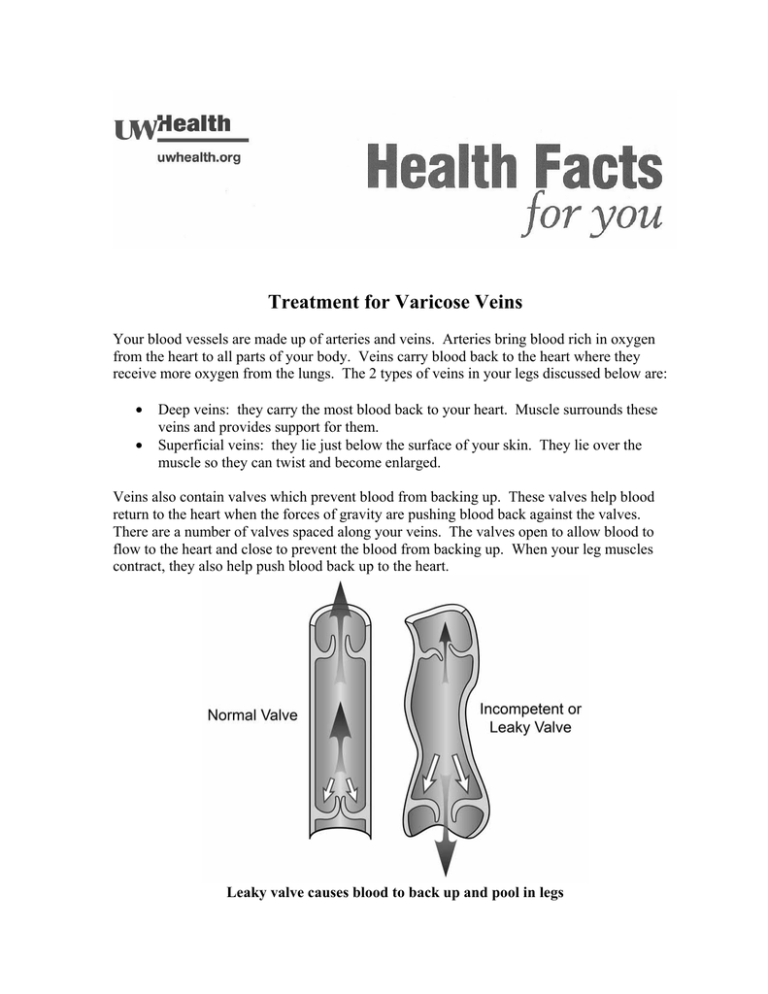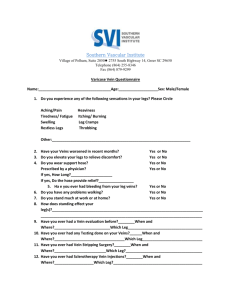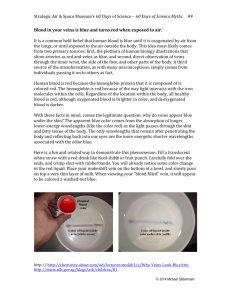
Treatment for Varicose Veins
Your blood vessels are made up of arteries and veins. Arteries bring blood rich in oxygen
from the heart to all parts of your body. Veins carry blood back to the heart where they
receive more oxygen from the lungs. The 2 types of veins in your legs discussed below are:
•
•
Deep veins: they carry the most blood back to your heart. Muscle surrounds these
veins and provides support for them.
Superficial veins: they lie just below the surface of your skin. They lie over the
muscle so they can twist and become enlarged.
Veins also contain valves which prevent blood from backing up. These valves help blood
return to the heart when the forces of gravity are pushing blood back against the valves.
There are a number of valves spaced along your veins. The valves open to allow blood to
flow to the heart and close to prevent the blood from backing up. When your leg muscles
contract, they also help push blood back up to the heart.
Leaky valve causes blood to back up and pool in legs
Varicose veins are superficial veins that have been stretched, twisted and dilated. They are
very common. Blood clots rarely form in them. They may be caused by:
•
•
•
•
•
•
•
•
•
Lack of muscle support in superficial veins
Family history
Obesity
Pregnancy
Weak vein walls
Valve problems – weak or absent valves
Occupations that demand standing for a long time
Female hormones
Blood clots in deep veins
Blood can pool in your legs if your valves do not close or become stretched. This pooling
can worsen the problem because of the high pressure against the walls of your veins. The
increased pressure makes the veins stretch more and bulge.
Spider veins are also superficial veins. They are very small damaged veins just under the
surface of the skin. They are called spider veins because they may look like a spider web or
even a bruise. They rarely are serious or cause problems but you may not like their
appearance. Sclerotherapy is the usual treatment for spider veins.
Symptoms
Symptoms of varicose veins include:
•
•
•
•
•
Heavy, aching legs when standing
Bulging, purple or blue veins just below the skin
Leg swelling
Discolored skin
Occasional bleeding with a leg injury
Tests
There are a number of treatment options. It depends how severe your varicose veins are.
Some tests you may have to decide the proper treatment are:
•
•
•
Venous Blood Flow Study: A test that checks for blockages in your deep veins.
Duplex Scan: This test also checks your veins and valves. It may show blockages or
faulty valves.
Venography: This test also checks your valves and for blockages in the veins.
Treatments
Based on the results of your tests, your doctor will give you treatment choices. These include
both non-surgery treatments and surgery. The goal of treatment is to relieve pain in your
legs, prevent bleeding from varicose veins and improve the appearance of your legs.
Treatment choices are:
•
•
•
•
•
•
•
•
•
Leg elevation
Use of support hose or ace bandages
Exercise
Weight loss
Avoiding prolonged standing
Sclerotherapy (varicose veins are injected with chemicals to make them disappear)
Endovenous laser ablation (heat from laser makes the vein collapse and disappear)
Radiofrequency ablation (radiofrequency energy makes the vein collapse and
disappear)
Vein ligation surgery
Sclerotherapy
This works best in treating spider veins but may also be used to treat varicose veins. Your
doctor will decide the best treatment for you. With this treatment, your doctor injects some
medicine into the swollen vein. This inflames the blood vessel and causes the walls of the
blood vessel to stick together and shrivel up. It can no longer fill with blood. The damaged
vein then disappears over time.
There is no special prep for this treatment. It may need to be done in a few sessions. The
doctor will adjust the amount of medicine based on your response to the first injection. You
may feel slight burning during the treatment.
Most patients are able to return to normal and go back to work right away. There may be
some bruising. It may take more than one treatment for each vein.
It is best to elevate your legs and wear compression stocking after the treatment. Walking is
good for you. Avoid sun exposure. Ask your doctor when you can apply sunscreen to the
treated areas
Endovenous Laser Treatment (EVLT) or Ablation
This is a minimally-invasive procedure done in the clinic. It takes from 30 minutes to 2
hours. You may receive some medicine to relax or sedate you first. If you get sedation, you
will need someone to drive you home.
The first 24 hours after your EVLT, you should not do any intense exercise, lift heavy
weights or sit in cramped quarters (such as in a car or airplane). The next day you should be
able to resume your normal activity. Exercise is good for you and helps blood flow back to
your heart.
You may have some mild pain, bruising, or feeling of tightness for a week. Take pain
medicine as ordered.
Wear compression stockings for the first 3 weeks. You may shower after 24 hours, but do
not take tub baths or swim for 1 week.
You will have numbing medicine injected into the skin. Then the laser is guided into the
vein using ultrasound. The laser heats the lining of the vein. This causes it to collapse,
shrink, and disappear.
Radio Frequency Ablation (RFA) and Stab Ablation Phlebectomy (SAP)
Radiofrequency ablation (RFA) is also a minimally-invasive treatment for varicose veins.
The doctor uses radiofrequency energy (instead of laser energy) to damage the varicose vein.
This forms scar tissue which closes off the varicose vein. It will likely be done as an
outpatient in the operating room. To prepare for RFA, read instructions below under Vein
Ligation Surgery.
Stab ablation phlebectomy (SAP) is a procedure where several tiny cuts (incisions) are
made in the skin through which the varicose vein is removed. SAP might be done along with
other treatments for varicose veins, such as ligation and stripping, laser treatment, or
radiofrequency treatment.
Vein Ligation Surgery and RFA
When the veins are removed in surgery, the upper end of the damaged vein is tied off and
removed. This will not affect blood flow in your legs because the blood will then flow
through the deep veins back to the heart. Both vein ligation surgery and RFA will likely be
done as an outpatient in the operating room.
Prior to Surgery
1. Be sure to keep wearing your compression stockings until surgery, as you were taught.
Bring them along to the hospital the day of surgery as you will wear one home on the
non-surgical leg.
2. A day or two before surgery, take a good look at the leg that will be operated on. Locate
the varicose veins. On the day of surgery the surgeon will mark the bulging varicose
veins with a surgical marker while you are standing upright. This is easier to do if you
know where your varicose veins are so that none are missed.
3. Do not eat or drink anything at least 6 hours prior to surgery. Generally what this means
is just don't eat or drink anything after midnight if you're having morning surgery, or after
breakfast if you're having afternoon surgery. If you do, your surgery will likely be
cancelled. There are some exceptions to this rule if you have diabetes or take certain
medicines. We will discuss this with you at your preoperative clinic visit.
4. Someone will call you sometime in the afternoon on the day before surgery. They will
ask you some questions about your health. You will be told when to arrive and where to
go the day of surgery.
5. You must arrange for someone to drive you home from the hospital and stay with
you that night. It is best if that person stays at the hospital during the surgery.
Day of Surgery
1. When you arrive, you will be shown to your preoperative holding suite and instructed
what to do as you get ready for surgery.
2. Nursing staff will ask you some questions and discuss the nature of your visit. They will
also review your health history, medicines and allergies, and give you an overview of
what to expect. They will review the specific surgery being done and check which side is
being operated on.
3. Nursing staff will start an intravenous (IV) line and prepare your leg by washing it with
sterile soap and water.
4. An Anesthesiologist will talk to you about the type of anesthesia planned, along with any
risks. You will be told what to expect and your questions will be answered.
5. Your Vascular Surgeon will stop by and answer any questions you or your family have
about your surgery. He or she will have you stand at the bedside while the visible
varicose veins on your leg are marked.
6. Then you will be brought to the operating room (OR) on a gurney. Family members may
wait in the waiting room until you return. We request that they stay in the hospital during
your surgery but it is not mandatory.
7. When you enter the OR, you will be met by the OR staff. They will transfer you from the
transport gurney to the OR table. The surgeon, the anesthesiologist, and nursing staff will
perform a final review of the procedure and surgical site. The anesthesiologist will then
give you anesthesia.
8. Your surgeon will then begin surgery with the help of a physician assistant and OR
technicians. When surgery is done, the small incisions will be closed with sutures, and
your leg will be wrapped with ace wraps from toe to groin. You will be awakened from
anesthesia and brought to the recovery room.
9. Most patients are in the recovery room for about 45 minutes. While there, you will slowly
become more awake. Nurses will be checking your vital signs, surgical dressings, and
asking about your pain. Once you are awake again, your vital signs are stable, and your
pain is under control, you will be brought to the post-operative ambulatory stay unit
where your family will be waiting for you.
10. Nursing staff will keep checking your vital signs, treat any surgery pain, change your
dressings if needed, and discuss discharge medicines and your care at home. You also
will be taught about special precautions. When your pain is under control, and you have
gone to the bathroom and walked around, you will be able to go home. This should take
about 1 to 2 hours.
Going Home after Surgery
1. You will need someone to pick you up and drive you home. You will not be able to
drive. You should sit sideways in the backseat with your feet up and resting on the seat.
You will be helped into your car by nursing staff, but you will have to be able to get out
on your own once you are home.
2. You may walk and bear as much weight as you can. While you will start out slowly, you
may progress daily as comfort allows. A rule of thumb to remember for the first week
after vein surgery: if you are up, then you are moving. If you are not moving, then you
should rest with your feet up.
3. When you get home, rest in a comfortable chair, couch, or recliner, but not your bed.
Keep both feet up on at least 1 pillow above horizontal. You should perform ankle
pumps with both legs about 3-4 times every 8-10 minutes. Get up and walk around the
house for 5-10 minutes every hour during the day before resting again. These hourly
walks are very important to help prevent blood clots.
4. When it's time to go to bed at night, simply place a pillow lengthwise under the surgical
leg from knee to ankle.
5. During the daytime you may also apply ice to your incisions over top the dressings. Ice
should feel cold but not freezing to the leg. This helps reduce pain, bleeding, bruising,
and swelling. You may use it as often as you prefer.
6. Do not lift more than 10 pounds. Do not do any strenuous, prolonged, or impact physical
activities or exercise for about 2 weeks after surgery. It may cause a sustained increase in
venous pressure.
7. Do not drive for at least 3 days after surgery or as long as you are taking narcotic pain
medicine. This is very important if you had surgery on your right leg.
8. Try to take some time off from work if you can. Be sure to plan for this before surgery.
Most patients need to be off work for 2-4 days after surgery. But you may need to be off
longer depending on the type of work that you do.
9. As you start to feel better each day after surgery, increase your walking speed and
duration...but remember the rule of thumb. You may go outside, go to the mall, and do
stairs as you feel better.
10. It is common to feel some pain right after surgery. You will be prescribed narcotic pain
pills at the time of surgery. Use it if you need it but if you don't need it, don't use it. If
you do, take it with some food as it can be hard on an empty stomach. Narcotics also
cause constipation so take a daily stool softener like Docusate while on pain pills.
Sometimes over-the-counter, non-narcotic pain medicines such as ibuprofen, Advil,
Tylenol, naproxen, or Aleve are preferred and work as well without narcotic side effects.
If this works for you, they may be used in place of narcotic pain pills.
11. At the time of surgery you might also be prescribed an anti-nausea medicine. Some
patients have nausea from narcotic pain medicine so this is prescribed for that reason.
Again, please take it only if you need to.
12. You may resume all of your regular home medicines again after surgery.
13. After surgery, your leg is wrapped with ace wraps from toe to groin. Keep this wrap
clean, dry, and in place for 48-72 hours, depending on when your follow up imaging and
appointment are (read #15 below). If it feels too tight, you may loosen it and rewrap it
the same way. Compression is vital right after surgery. This means you should sponge
bathe at the sink for the first few days after surgery. Wear a compression stocking on
your other leg.
14. If you see any blood seeping through the dressings before you are permitted to shower
(see #15 below), do not remove the dressings. Instead, cover the area with gauze
dressings and more ace wrap. We will provide you with extra ace wraps at discharge.
15. You may remove your bandages and shower on postoperative day 3. If you are
scheduled to come back for your follow up imaging and appointment before this,
you may remove your bandages and shower the morning of your appointment.
Shower and gently wash your leg and incisions with soap and water. Pat dry and rewrap
your leg with new or clean ace wraps from toe to groin (see below or ace wrap
instructions). You may use antibiotic ointment and gauze dressings under the ace wraps if
you wish. The dressings should stay on during the day and be taken off for the night at
bedtime. Keep doing this for 7-10 more days with the surgical leg. Then return to using
compression stockings on both legs. You should still be using a compression stocking
during the day on the non-surgical leg during this entire period of time.
16. Most patients have 2 clinic visits for follow-up at UW Health West Clinic on Junction
Road. The first will be 2-3 days after surgery for venous imaging of the surgical leg.
This test ensures that certain veins are closed off and that no blood clot has formed. It
will be done by the vascular technologist. Your dressings will be changed at this time.
The second clinic visit will be about 1 week after surgery when your sutures will be
removed by one of the midlevel practitioners.
17. Do not soak in a tub or swim for 1 week.
When to Call the Doctor:
After 2 days, you should look at your incisions daily for signs of infection. Call if you
notice:
•
•
•
•
•
•
•
Red and warm incision
Foul smelling or pus from incision (yellow or green drainage)
Temperature over 100.4° F for 2 readings taken 4 hours apart
Increased swelling, firmness or tenderness around the incisions
An opening in the incision
Severe pain, not relieved with elevation, rest or pain medicine
Changes in blood flow in leg – unusual coolness, swelling, pale or blue color,
numbness or tingling.
Phone Numbers
Monday-Friday, 8:00 am – 5:00 pm, call the Peripheral Vascular (PVS) Clinic at UW Health
West Clinic at (608) 263-8915.
After hours, weekends and holidays, this number will give you the paging operator. Ask for
the PVS doctor on call. Leave your name and phone number with the area code. The doctor
will call you back.
If you live out of the area, call 1-800-323-8942.
Copyright © 11/2013. University of Wisconsin Hospitals and Clinics Authority. All rights reserved. Produced
by the Department of Nursing HF#7573
How to Apply Ace Wraps to the Legs
1.
Use a 4 inch ace bandage for the foot and lower
leg. A 6 inch ace bandage might be best for adult
thighs. (In children and smaller adults the width
of the ace bandage will be chosen based on the
size of the child). Start the ace wrap at the top of
the foot, just below the toes. Wrap over the top of
the foot and around the back of the foot. This will
secure the ace bandage and prevent the ace
bandage from riding up the leg.
2.
Pull the ace wrap diagonally, not at a right angle to
the leg.
3.
Wrap up the foot diagonally,
reversing the direction with
each turn.
4, 5. Keep wrapping in a crisscross pattern, adding the most
pressure as you wrap up the
foot, toward the ankle.
6,7,8. As you apply the ace wrap
around the ankle, begin to
move up the leg, using the
same technique. Apply less
and less pressure as you move
up toward the body.
9,10.Keep wrapping up the thigh and
secure the end of the ace wrap with
metal clips or tape. Check the toes
to see if they are pink and warm.
There should not be any numbness or
tingling. If the toes become paler,
cool, numb, or tingle, the ace
bandage may be too tight. Remove
and rewrap the ace bandage to apply
correct pressure without cutting off
the circulation.






